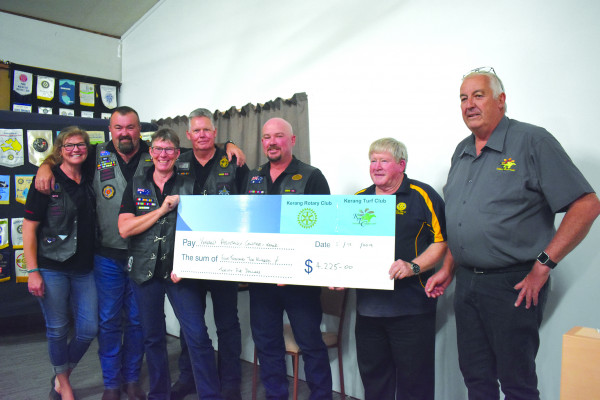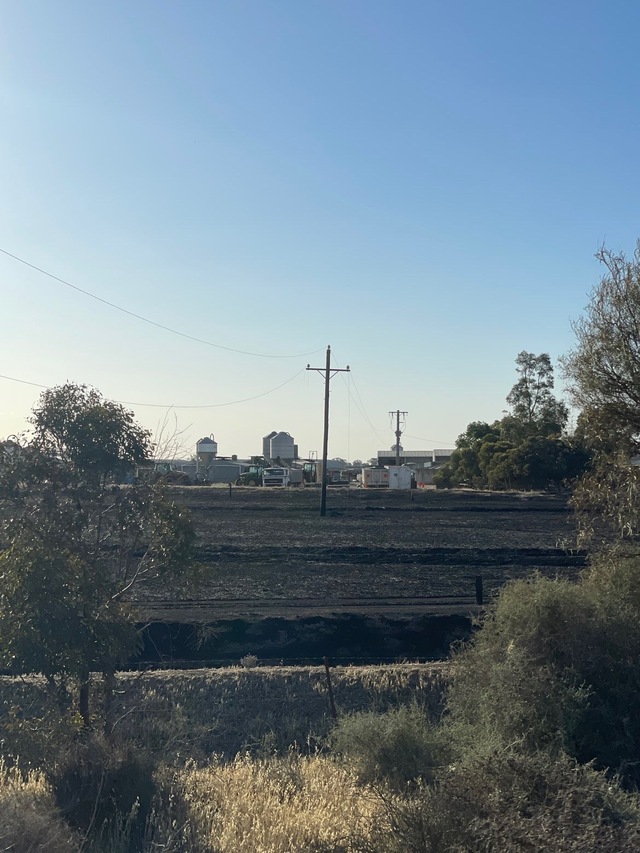The unusually named Military Brotherhood Military Motorcycle Club reaches out to former defence force members who may be struggling with their reintegration into civilian life.
Kerang’s Northern Victorian sub-branch of the organisation recently received generous financial assistance from the Kerang Turf Club and the Rotary Club of Kerang.
The Military Brotherhood has established a presence at Kerang’s RSL, using the building as a base for its Veterans Assistance Centre (VAC), which it opened on Remembrance Day.
Initially, the Kerang VAC, named Tamar after an Australian Army operation in Rwanda, will operate two Mondays a month.
Scott Strachan, president of the Turf Club, was overcome with emotion as he addressed local Military Brotherhood members at Kerang Rotary Club before presenting a giant cheque for $4225 to the Brotherhood’s Shayne Mostyn and Stephen Mahoney.
Mr Strachan was quick to jump on board when Kerang Rotary put forward the Military Brotherhood as a worthy recipient for funds raised at the Turf Club’s Melbourne Cup Day event, reflecting on the mental health struggles of someone close to him.
“When this came up, I could see the benefits for your members to be steered in the right direction,” he told the assembled brotherhood group.
The Rotary Club of Kerang joined with the Kerang Turf Club to raise funds together on Melbourne Cup Day.
This year around 120 people enjoyed a catered lunch and afternoon tea run by the Rotary Club at the Kerang racecourse.
Mr Mostyn, vice president of the Brotherhood’s Northern Victorian sub branch and Mr Mahoney, its president, spoke at length about the work of the Military Brotherhood and the challenges it faced, such as the grim statistics on the high rates of veterans’ attrition through suicide.
Surprisingly, finding locally-based military veterans is the biggest challenge the organisation encounters, with most effectively disappearing once they are discharged.
Little effort has been made to keep track of service men and women once they return to civilian life, despite the often rocky transition that entails.
“It’s one of those unusual jobs, that when you leave you carry on, you have a normal life, or you try to, but there’s always that little something missing,” Mr Mahoney said.
Mr Mostyn detailed the shock which was experienced when transitioning.
“You go straight from the regimented military lifestyle where every day is planned out for you, to being suddenly on your own with no structures in place,” Mr Mostyn said.
He said that since 1998, Australia had lost 48 service personnel through military action, explaining more than 10 times that number have lost the battle with the demons of conflict.
“In that same time frame, from 1998 to last year, we’ve lost over 500 to suicide. It’s a blight on the Australian military.”
The largest number of those deaths is attributed to those Australian veterans exposed to atrocities during the genocide in Rwanda during the 1994-1996 operation that gave the Kerang VAC its Tamar moniker.
“Veterans of Rwanda have a higher suicide rate than any other conflict in the history of the Australian Defence Force,” Mr Mostyn said.
Mr Mahoney said the grim suicide statistics had prompted some improvements, with the Department of Veterans Affairs reaching out through measures such as introducing a Veterans Covenant which includes a card providing returned service personnel with free mental health services.
Anyone who has completed at least one continuous day of Australian military service is entitled to that assistance.
However, the challenge of locating veterans is a major impediment to providing assistance to many in need.
The brotherhood is there to support veterans and their families.
It can be as simple as letting people know what help they are entitled to.







